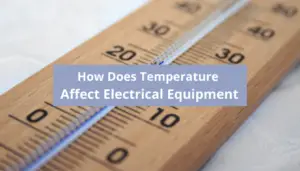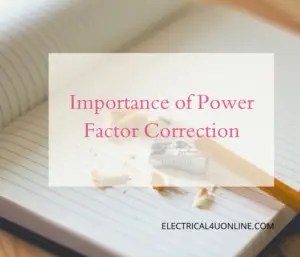Have you ever wondered why an electric motor might seem to draw more power than usual? Let’s explore the reasons behind this phenomenon and how it impacts our devices.
As an electrical engineer with more than a decade of practical experience, I can confidently say, that electric motors draw more current when dealing with heavy loads (overloading), voltage drop, mechanical issues (like bad bearing), or internal electrical issues (internal short circuit).
Picture this: you press the start button on your washing machine, and suddenly, the lights in your home dim for a moment.
What’s happening here? It’s all about electric motor current draw – a topic that might sound technical, but it’s more relevant than you might think.
Table of Contents
Factors Influencing High Current Draw
Mechanical Factors Impact on Motor Current Draw
Mechanical Overload:
Imagine trying to push a car uphill – it’s tough! Similarly, when a motor faces a mechanical overload, like a machine trying to lift a heavy object, it needs to work harder.
This increased workload demands more power, leading to a higher current draw. It’s like your motor is flexing its muscles to handle the extra effort, resulting in a temporary surge in electricity consumption.
Bad Bearing:
Think of bearings as the joints of a motor. If these joints are creaky or damaged (like a rusty bike chain), the motor has a hard time turning smoothly.
This creates friction and resistance, making the motor struggle to spin. To overcome this difficulty, the motor needs more power, which translates into higher current draw. Just as it’s harder to pedal a bike with a rusty chain, a motor with a bad bearing needs more energy to keep things moving.
Misalignment:
Imagine a wheel that’s not aligned properly on a car – it can lead to wobbling and uneven movement. Similarly, if a motor’s components are misaligned, it encounters resistance when trying to rotate.
This misalignment increases the load on the motor, demanding more power to compensate for the uneven movement.
This translates to a higher current draw as the motor works harder to push through the misalignment and maintain its intended motion.
In all these cases, the mechanical factors create additional challenges for the motor, prompting it to draw more currenttoo effectively handle the increased load, resistance, or misalignment.
Electrical Factors Impact on Motor Current Draw
Voltage Drop:
Think of voltage as the “push” that drives the motor. If there’s a drop in the voltage supplied to the motor, it’s like giving it less power to work with.
When the motor doesn’t receive the necessary voltage, it struggles to produce the same amount of output.
To compensate, it draws more current to maintain its performance. It’s like trying to run while someone is holding you back – you push harder to maintain your speed, and similarly, the motor draws more current to keep things moving smoothly despite the lower voltage.
Frequency Fluctuations:
Imagine playing a musical instrument with changing notes. Motors rely on a consistent frequency, or cycles per second, to operate optimally.
If the frequency fluctuates, it disrupts the motor’s rhythm. Just as a musician might struggle to play a melody with changing beats, the motor might struggle to maintain its speed and performance.
To cope with this inconsistency, the motor draws more current to stabilize its operation and compensate for the frequency changes.
Uneven Phases in Three-Phase Power:
For industrial setups, three-phase power is common. If there’s an imbalance in the phases – meaning one phase has more load than the others – it can lead to uneven distribution of power to the motor.
It’s like having one person carrying most of the weight in a team exercise. The motor has to work harder to handle this imbalance, which results in increased current draw.
Power Factor Issues:
The power factor is like the efficiency of your motor. If it’s low, the motor might not be using the electrical power as efficiently as it could.
This can cause the motor to draw more current to achieve the desired output. It’s like using more water from the tap because your faucet isn’t working efficiently.
The motor compensates for this inefficiency by pulling in extra current to maintain its performance level.
In each of these cases, electrical factors introduce challenges that affect the motor’s ability to operate smoothly.
The motor responds by drawing higher current to adapt to the changing voltage, frequency, phase imbalances, or power factor issues and ensure consistent performance despite these electrical variations.
Internal Motor Components
Inside your motor, there are winding coils and bearings working together. If any of these components develop issues like short circuits, open circuits, or bearing problems, the motor has to work harder.
This can lead to a higher current draw. It’s like a traffic jam on your way to work – you’re burning more gas to keep moving.
External Conditions
Temperature Extremes:
Just like extreme weather affects your energy levels, temperature can impact a motor’s performance.
In hotter conditions, motors can heat up, leading to increased resistance in their components. This extra resistance demands more power to overcome, causing the motor to draw a higher current. It’s like needing more energy to run in scorching heat.
Dust and Humidity:
Dust and humidity might not bother you much, but they can trouble motors. Dust can clog motor components, creating friction and resistance.
Similarly, high humidity can lead to moisture entering the motor, affecting its insulation and causing electrical issues. In both cases, the motor needs to work harder to maintain its function, resulting ina higher current draw.
Vibration and Shock:
Imagine trying to write while riding a bumpy bus – it’s tough to keep a steady hand. Similarly, if a motor is exposed to constant vibration or sudden shocks, it can throw off its internal components.
This makes the motor work less efficiently, demanding more current to maintain its operation. It’s like trying to read while being jostled around.
Improper Cooling:
Just as you might overheat if you’re not dressed properly in hot weather, a motor can overheat if it’s not adequately cooled. Heat buildup affects the motor’s efficiency and can increase resistance within its components.
To counteract this, the motor draws more current to handle the increased load caused by the heat. For more information read my comprehensive article: Motor temperature rise.
In all these situations, external conditions can create hurdles for the motor’s smooth operation. The motor responds by drawing a higher current to overcome challenges posed by temperature extremes, dust, humidity, vibration, shock, and cooling issues, ensuring it continues functioning despite these external factors.
Consequences of High Current Draw
Overheating and Efficiency Loss
Imagine running on a treadmill at full speed – you’d heat up pretty quickly. Similarly, when a motor draws excessive current, it generates more heat.
This heat can lead to inefficiency, making your motor unreliable and using more electricity than necessary.
Wear and Tear
Excessive current can wear down your motor’s components faster, like constantly running your car engine at high RPM. This means more frequent repairs and replacements, costing you time and money.
Diagnosing High Current Draw Issues
Performance Monitoring
Think of your motor as a heart rate monitor for your appliances. Tools can help you track if it’s drawing too much current, signaling potential issues.
Visual Inspection
If you see frayed wires, or dark marks, or hear strange noises, it’s like your motor’s way of saying, “Help, I’m struggling!”
Voltage and Frequency Analysis
If you provide your motor with the right “fuel” – proper voltage and frequency – it’s more likely to run smoothly without drawing excess current.
Addressing and Preventing High Current Draw
Maintenance Best Practices
Just like changing your car’s oil, your motor needs regular attention. Proper lubrication and cleaning can keep it running efficiently.
Load Management
Matching the motor’s power to the task at hand – like using a sledgehammer for tough jobs and a regular hammer for lighter ones – can reduce current draw.
Voltage Stabilization
Think of a surge protector as your motor’s “insurance policy.” It helps stabilize voltage and protects against sudden power spikes that can cause a high current draw.
Professional Assistance
When in doubt, consult an expert. Just as you’d see a doctor for a health issue, reaching out to an electrician can save you from bigger problems down the road.
Conclusion
Understanding electric motor current draw might feel like diving into the deep end of a pool, but it’s all about making sure your appliances work efficiently and reliably.
By knowing the factors at play, you can take simple steps to ensure your motors run smoothly and save both energy and money in the long run.
Don’t Leave Empty-Handed!
Install my Free Android App on Google Play:
Electrical Cables Most Common Tables “Cables Tables”
And, my Electrical Calculations App “Fast Electrical Calculator”
Discover more great content by subscribing to My channel
Looking to stay ahead of the game in the world of electrical engineering? Subscribe to my YouTube channel and gain access to exclusive content you won’t find anywhere else!
The staff I recommend
(Amazon Affiliate Links to products I believe are high quality):
- Economy 120 Volt/60Hz AC Power Source – Step-Down Voltage & Frequency Converters 1800W
- UNI-T Digital Multimeter Tester UT139C
- 50-Amp Extension Cord for RV “100ft”
- Voltage Stabilizer 110/220v
- Hair Dryer “best selling“
- TOSHIBA EM131A5C-BS Countertop Microwave Ovens
Disclaimer: This contains affiliate links to Amazon products. I may earn a commission for purchases made through these links.



